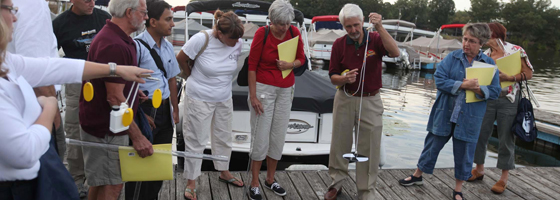Volunteer monitors are watchdogs for Ohio lakes

In May 2009, Grand Lake St. Marys, a lake in western Ohio constructed in the mid-1800s to store water for the Miami-Erie Canal, experienced an outbreak of algae that made lake-goers think twice before taking a dip.
The U.S. Environmental Protection Agency posted signs advising limited contact with the lake. Water samples showed 82 times the amount of microcystin recommended for safe drinking water.
The bloom cleared briefly the following winter, but returned with vigor in June 2010. An even more toxic species of blue-green algae had taken over the lake and new signs appeared on the beaches, this time advising no contact with lake water.
At nearly 13,000 acres, Grand Lake St. Marys is the largest inland lake in Ohio and supplies drinking water to the nearby city of Celina. Three years after the initial outbreak, recreational users of the lake are still advised against swimming and wading in the water.
Dana Oleskiewicz, program director at the Ohio Lake Management Society, hopes to prevent harmful algae outbreaks like the one at Grand Lake St. Marys in the future. Oleskiewicz works with the Citizen Lake Awareness and Monitoring (CLAM) program to monitor the health of Ohio waterways. Ohio citizens involved in CLAM all do so on a volunteer basis. The volunteers, called “lake keepers,” collect water quality data on 30 lakes in Ohio.
The lake keepers are usually residents who live on or near a lake and have a boat. The OLMS provides the volunteers with monitoring equipment, including handheld dissolved oxygen meters. After taking water quality readings, the volunteers enter the results into an online database that is accessible to the public at www.eyesonthewater.org/olms.
The CLAM program has existed for 20 years, but until 2011, volunteers only took transparency readings. Through the Muskingum Watershed Conservancy District, the program received funding to do harmful algae sampling and other measurements at nine lakes in the Muskingum watershed.
“Muskingum was very pleased with the outcome because we’re a watchdog,” Oleskiewicz said. “We watch for the harmful algal blooms, and all of the nine lakes have reported in early July, and we are seeing the levels of the toxin below what the EPA considers to be a health risk.”
Volunteers sample the nine Muskingum lakes at a beach or dock—some place where the general public has access to water—and send samples to a lab. The lab counts algae cells and runs a chemical analysis for algae toxins.
In addition to monitoring for algal blooms, OLMS has funding to document changes in water conditions at the Muskingum lakes.
“We also have the lake keepers do a temperature profile and a dissolved oxygen profile. So we’re looking at the lake—when does it turn over? When does it go anoxic?” Oleskiewicz said. “That’s a seasonal thing. They start out in May and go all the way through October, and they’re taking a profile all the way from the dam up to where the rivers comes into the lake.”
Recently, through funding from the Muskingum Conservancy Watershed District, the OLMS has been able to offer lake keepers a small stipend that covers gas for sampling trips. The concern for lake water quality is evident in the commitment of the volunteers. “The one thing that really amazes me is we’ve had volunteers that have been with us for 15 plus years. The funding comes into the program sporadically, but those volunteers continue to collect the data even if there’s not any funding for it.” Oleskiewicz said.
As for the future of the program, Oleskiewicz hopes to add more lakes to monitor for both transparency and HABs. The OLMS is fundraising to take the HAB program that they are doing in Muskingum statewide.
Image: CLAM training on Portage Lakes, September 2010 (Credit: Lew Stamp Photography)




0 comments